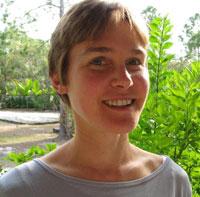Maia Hallward, Ph.D and assistant professor in the department of political science and international affairs at Kennesaw State University, spoke at Guilford on Sept. 21, which appropriately happened to be World Peace Day. Her presentation was entitled “Struggling for a Just Peace in the Second Intifada” and centered on the Israeli/Palestinian conflict.
The Second Intifada is the most recent of two Palestinian uprisings against the Israelis, marked by intensified periods of violence and division between the people.
While Hallward provided a solid background about the conflicts between Israel and Palestine, her lecture focused on how they can move toward a peaceful coexistence in the future and how, even though the divide between the two cultures seems so wide, they are not so different after all.
“Palestinians and Israelis are humans with human desires, fears, (and) loves like everyone else,” said Hallward in an email interview. “Palestinian and Israeli mothers and fathers do not want harm to come to their children, and Israeli and Palestinian children are afraid of the ‘other’ side and what may happen. Although their contexts are different (and) power asymmetries (are) great, efforts to dehumanize either side or any party to the conflict only further perpetuates conflict.”
Unfortunately, the struggle for peace is becoming more difficult, according to Hallward. As physical, emotional, and psychological divides broaden, it becomes more challenging for Israelis and Palestinians to communicate across them.
“You have the most right-wing government in Israel in its history,” said Max Carter, director of Friends Center and Campus Ministry Coordinator and Hallward’s father. “You also have the physical barriers that have emerged …Where it manifests itself in urban areas, it’s a 26-foot high solid concrete wall.”
As tensions rise, the psychological boundaries Hallward mentioned rise along with them.
“Israelis need to humanize the Palestinians and provide images and stories of them that are more than bloodthirsty terrorists,” said Hallward.
This was an enduring message from the presentation. No matter where someone is born or what group they support, we are all people and can find our connected to each other, even when it seems we are separated on so many fundamental levels.
Hallward took great care to present the conflict in a fair, unbiased way, which was one of the most impressive aspects of her lecture.
“I thought it was very evenly-sided,” said Senior Heather von Bodungen. “That it’s possible to be pro-Palestinian rights and not anti-Israeli … she presented both sides very well, I thought.”
“It was really interesting and I learned a lot,” said Junior Allison Semmler. “Before the presentation, I didn’t know a lot about the Israeli/Palestinian conflict, so it really opened my eyes to this issue and made me want to explore it further.”
Hallward focused on the idea of how peace means different things to different people. According to Hallward, the Israelis are aiming for a more “negative peace”. Their idea of peace has to do with an absence of violence in their everyday lives.
The Palestinians, on the other hand, hope for a more “positive peace” in having the ability to move freely throughout their country. The restricted movement is one of the biggest obstacles to peace that the Israelis and Palestinians face today.
“The checkpoints have restricted travel to such an extent that Palestinians and Israelis just can’t get together,” said Carter. “Israelis are forbidden by law, by their own government, to go into Palestinian territory if they’re not in the military. They can’t travel into Jerusalem, to Israel. So that has prevented the face-to-face conversations.”
Carter said that the pockets of Palestinian land are set up like “60 holes in Swiss cheese, with the entire West Bank cut in the middle.”
Hallward talked about what mechanisms can be used to build peace, such as starting peaceful institutions across cultural barriers, raising awareness of what is really going on, and using constructive confrontation to find solutions to those problems.
She also discussed how people are talking about what went wrong in the brokerage for peace, but no one is discussing what went right. Through her first-hand observations living and teaching in Israel and Palestine, Hallward saw that the peace organization that were the most successful were based in equality and used a consensual decision-making process similar to the Quaker process.

